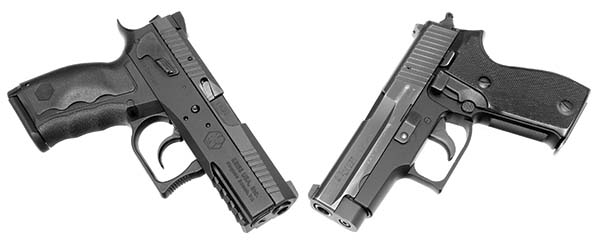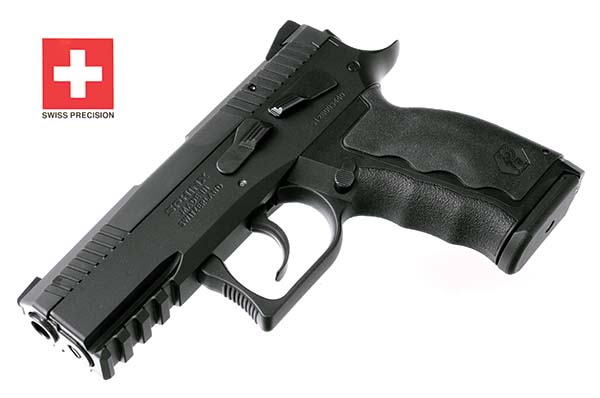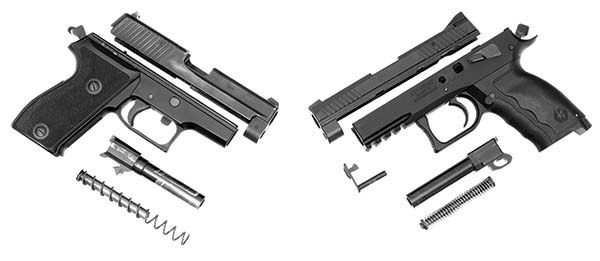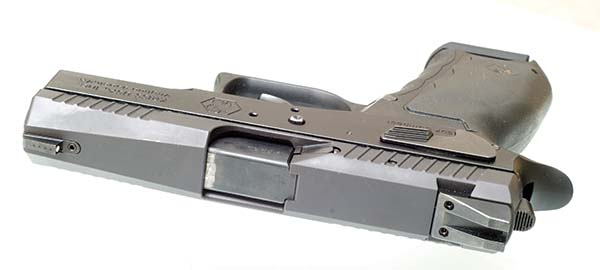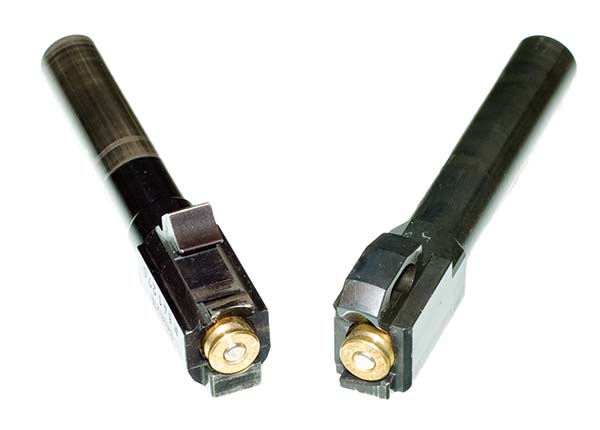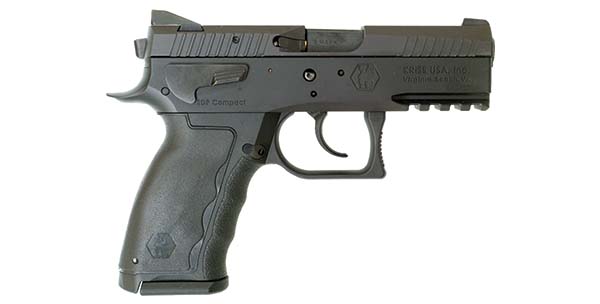Sphinx SDP Compact
Sphinx Systems Limited is a Swiss-based manufacturer that produces an evolved CZ 75 design, and while their previous offerings have been rather expensive, the SDP Compact Alpha is priced around the $1,000 USD mark and is affordable to a wider segment of shooters. The SIG Sauer P-series is similarly priced and features the same Double-Action / Single-Action (DA/SA) hammer fired format. This article pits the 9x19mm SDP against the same caliber SIG P6 (German police version of the P225). Because the P-series is broadly similar, the comparisons will transfer to the likes of the P229.
Handling Impressions
The most distinctive feature of the SDP slide is that it rides inside the full-length rail of the frame. Although it has a tight fit, there are minute side-to-side movements similar in magnitude to the P6. The SIG P210 also has this slide-inside-frame design, and there are claims that this lends accuracy. While it is beyond the author’s shooting ability to verify this claim, this feature impairs handling by those with low hand strength.
Because some of the slide is covered by the frame, there is less purchase available for manipulation, and this is amplified by the strong recoil spring. One can feel two distinct stages in cycling the SDP: the first 15mm is relatively easy, but the rest takes more strength. While the author had no trouble cycling the slide, two female testers found it nearly impossible despite the respectable slide serrations. This could present a challenge in performing a traditional chamber check where the slide is slightly withdrawn so brass can be clearly seen or felt. Instead, the SDP features two loaded chamber indications: a bump on the external extractor standing out of the slide and a 1mm gap between the slide and right side of the barrel where brass can be seen. The SDP may benefit from “charging supports” similar to that found on the HK VP9, and a straight edged rear sight to assist in one-handed manipulation.
The SDP barrel showcases how Sphinx evolved the CZ 75 design. It shares the enclosed cam track that unlocks the breech via the slide release lever pin from the CZ 75 design, which itself is derived from John Browning’s 1911/Hi-Power. But having the barrel hood locking up against the ejection port follows the practices of current designs such as SIG and Glock, whereas the CZ 75 utilizes the John Browning design (also seen in the 1911/Hi-Power) where cams on the barrel lock into recesses in the slide. In addition, the SDP features polygonal rifling that the author found to ease the cleaning process. Happily, the very tight barrel to slide fit of the CZ 75 is continued in the SDP, no doubt promoting consistency. It is noteworthy that CZ evolved their design down a different path in the P07; like a SIG P-series, it features an open cam track, lockup via barrel hood and ejection port, and traditional rifling. In addition, the P07 features an entirely polymer frame and the slide rides in two steel inserts embedded in the polymer, similar to the current Glock or HK designs.
SDP barrel features good chamber support, though it is marginally less than that found on the P6. The feed ramp on the SDP is polished and is entirely on the barrel. The P6 feed ramp is partly on the barrel and partly on the steel locking insert. Using ball and hollow-point, hand-loaded and factory ammunition, both pistols functioned reliably and produced no bulged cases.
Bore axis is defined as the distance between the bore and web of the shooting hand, representing the moment between the recoil force and the rotation point. It stands to reason that lower bore axis generates less muzzle flip. While the SIG P6 has a marginally higher bore axis than the SDP, the author actually found better split times with the P6, though this can be attributed to his familiarity with the SIG.
The SDP field strips the same way as the CZ 75. The slide is moved slightly back until the hash marks line up on the slide and frame, and then the slide release pin is pushed out and removed. The slide is then free to move forward off the frame, the captured recoil spring withdrawn from the slide, and the barrel removed for cleaning. This is similar to the 1911 and Hi-Power designs, but those pistols require the slide to be drawn further back and while the safety lever holds the slide in place, the slide release is withdrawn. In comparison, the P6 strips much more easily with the slide release holding open the slide and the take down lever rotating 90 degrees before the slide can be withdrawn from the frame. While both female testers had some trouble holding the SDP slide open and pushing out the slide release lever pin, neither had much trouble field stripping the P6. The captured recoil spring of the SDP, in contrast to the P6, is a nice touch to avoid launching parts across the room.
Unlike Beretta/HK/CZ P07, the SDP decocker does not slam the hammer (driven by the hammer spring) onto the firing pin block or half notch intercept. Like the P6, depressing the decocker unlocks the hammer and releasing the decocker lowers the hammer. The SDP decocker cams-over at the halfway point and the hammer reach the half notch intercept with some vigor. In that respect, it is closer to the SIG SP2022 than the classic P-series. The SDP decocker has a small shelf that aids in lowering the profile of the pistol, but the author found it difficult to use with one finger. Instead, he prefers to actuate the lever with both the thumb and shooting finger on both sides
of the frame.
The author favors DA/SA hammer fired pistols for safety and the ability to thumb cock for an accurate first shot (versus a striker design like the P99AS). Unfortunately, the abbreviated hammer of the SDP is difficult to manipulate because of reduced surface area. Also of note is that once fired, the hammer rests flush against the slide and cannot be manually drawn back. This could hamper the clearing of a dud round where one must overcome both the hammer and recoil springs to extract the faulty round. A workaround would be to pull the trigger slightly until an audible click is heard, in order to put the hammer in the half notch intercept position, then use the thumb to fully cock the hammer. In contrast, the P6 hammer returns to the half notch intercept after firing and can be manipulated to relieve the hammer spring pressure before extraction. The author would like to see Sphinx releasing a full sized hammer to address these concerns.
The slide release is located in the same place as the 1911/Hi-Power/CZ 75, and is more easily reached by the supporting-hand than shooting-hand thumb. Because the slide release must be removed for field stripping, it cannot be ambidextrous or reversible; left handed shooters must utilize the sling-shot method for releasing the slide. Given the author primarily uses a SIG, he did find it somewhat slower to wait for the support hand to release the slide rather than releasing it with the shooting hand thumb right when the magazine seats, but that can be mitigated through training. Like the decocker, the slide release has a small shelf that the author found difficult to actuate quickly, and both female testers resorted to the sling shot method.
The SDP is equipped with a rubber recoil buffer to soften the firing impulse and promote durability. Post-WWII Walther P38 and early P1 utilized an aluminum frame to reduce weight, but experienced frame cracking from the impact of the steel slide. Improved P1 addressed this with a wider slide to reduce slide velocity, and a steel pin in the frame to absorb the impact. SIG P6 evolved that concept so that the steel locking block serves to both absorb the slide impact and to cam the barrel down and unlock the breech. Like the HK P9S, SDP features a rubber-like buffer that is separate from the recoil spring and softens the blow.
The SDP upper frame comprises of the aluminum chassis containing the full length rail and fire control components, and a polymer lower frame that forms the grip. The two parts are attached via screws under the front of the trigger guard, near the magazine release, and presumably in the rear near the hammer spring. The author found the two parts solidly and seamlessly attached. The Alpha line utilizes a polymer grip, other lines (e.g. Krypton, Sand) utilize an aluminum lower frame, and the Stainless Steel line uses stainless steel for both parts of the frame. The user-changeable polymer grip panel, while soft and lacking aggressive checkering or stippling, does not slip when wet and is very comfortable. When changing the grip, the user must take care to align the rails on the lower frame to the troughs in the grip, and lightly pinch the grip to seat it. Failure to do so would result in some flex on the sides. The author found these grips vastly superior to the hard plastic checkered grips of the P6.
The SDP features a comfortable beavertail like that found on the P229 Elite. However, the author believes slide/hammer bite is not a great danger and the beavertail merely adds a printing factor when carrying concealed.
Finally, the frame over slide design means plenty of places to rest the support hand thumb when using a thumbs forward grip. In fact, the author found the lettering “SPHINX, MADE IN SWITZERLAND” a good tactile index for the thumb.
Shooting Impressions
SDP rear sight is a plain black U-notch type typically found on target pistols, and it features fine serrations to cut down glare. The channel between the “U” is marginally wider than the P6 or Glock 17, presumably to allow faster sight alignment in the absence of “3-dot” or “bar-dot” arrangement. In practice, the author did not experience increased lateral dispersion. However, he favors the “bar-dot” arrangement typically found on German made SIGs and would love to see such an option for the SDP.
Testing was performed with factory 115gr Winchester “White Box” ammunition, and hand-loaded 147gr 0.356” round-nose plated projectile from Xtreme placed atop 3.2gr of Red Dot powder and a CCI #500 primer (the author makes no claim on safety or performance of this load). As an aside, the author shot both loads in a dim indoor range and noticed the 115gr produced more muzzle blast and flash even in the longer barreled Glock 17. The 147gr also generated a softer recoil impulse and impacted higher than the 115gr.
The author found the SDP to require a “cover-the-target” hold familiar to SIG users. At 5yd, 147gr point-of-impact is about 4cm lower than the top of the front sight and roughly matches the white dot painted on the front sight. It appears the front sight, being screwed into a lengthwise slot, can be replaced without changing windage. Sphinx should consider shipping the pistol with an additional, lower, front sight for those preferring a “6 o’clock” hold.
While the SDP double action trigger did not initially feel as smooth as the worn-in P6, it improved quickly and the author expects it to wear well. With the original, heavy, hammer spring in the P6, the author registered low hits in double action because the trigger finger pulled the nose low; this was alleviated by substituting a lighter P225 spring. The author experienced the same problem with the heavy double action trigger of the SDP, and is looking forward to having a lighter hammer spring.
The SDP single action trigger, just like the P6, can be best described as a “rolling trigger” rather than a “glass rod trigger” typically found in tuned 1911s or match rifles. There is a long “take-up” inherent in DA/SA design before hitting a well-defined “wall.” Amounting to about 1mm when measured at the tip of the trigger, the creep is evident only when one is consciously trying to feel it. Similarly, a Glock trigger can feel stiff and bumpy when shooting bullseye, but that feeling goes unnoticed when shooting fast. The SDP trigger does not stack before the shot breaks. The author prefers a “rolling trigger” because it reinforces a smooth stroke, rather than a sudden jerk that results from trying to time a shot. The author also notes that the trigger at rest contacts the frame and wears it down to bare aluminum after only 200 rounds.
The SDP trigger reset feels average like the P6, but its strong trigger return spring distinguishes it. The author does not ride the trigger reset, but prefers to release the trigger fairly far forward before “prepping” it for the next shot. The author appreciates how the strong trigger return spring propels the finger forward and gives positive feedback.
The author conducted an informal test by shooting the SDP and P6 as fast as possible at 5yards while keeping the groups within 3inches. The aforementioned 147gr hand-loaded ammunition was used. For an eight shot string, the SDP split time averaged 0.71secs, and the P6 averaged 0.65secs. The author felt that the P6 had more muzzle flip, but his familiarity with the firearm allowed for faster recovery. In addition, the author needed additional time to align the sights of the SDP while the bar-dot arrangement of the P6 felt more intuitive.
Final Thoughts
The Sphinx SDP has excellent fit and finish and is both accurate and reliable, just like the SIG P6. While the SDP has superior ergonomics for a typical user, it falls short on ease of manipulation across demographics: both female testers had trouble cycling the slide and actuating levers. This gives pause to selecting the SDP as a defensive firearm for those typically with lower hand strength such as females or the elderly. If designated as a home defense tool, it is advisable to ensure the entire family can manipulate the firearm.
Considering the CZ SP01 and P07 are about half the price of an SDP, prospective buyers would be well advised to handle and shoot each to ascertain if the SDP is worth the premium.
The author would like to see the following as improvements or options:
1. Add charging support similar to those found on the VP9
2. Rear sight with perpendicular leading edge for one-handed manipulation
3. Bar-Dot sight setup with a narrower rear sight channel
4. Include additional front sight from factory that would give a 6 o’clock hold
5. Full hammer
6. No beaver tail
7. Lighter hammer spring






